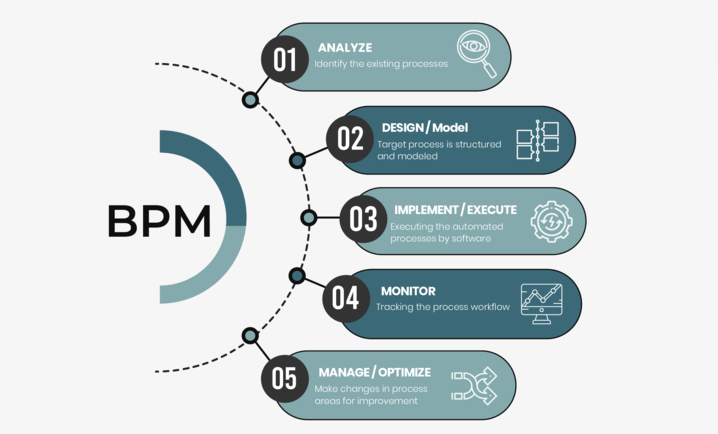Companies perform different steps to implement BPM. It is noted that there are certainly innumerable life cycles and each expert has his own variant. What they all have in common is that processes are optimized.
5 working steps are the structure or a lifecycle for successful and efficient control of business processes. We define steps in a general format (AMEMO) which includes:
Ideally, Process Management deals with monitoring and optimizing existing processes along with analyzing the scope of new processes. Usually, companies use manual work steps to handle BPM. But with digitization, can such processes be bound by technology?
The answer is yes! Automation of the BPM process has been shown to increase the profitability and customer focus in many companies as it focuses on optimizing process quality.
Modern technologies like “Robotic Process Automation” and “Artificial Intelligence” have contributed to automating BPM processes to a great extent. RPA process automates the manual, repetitive process that primarily focuses on classic administrative tasks. AI in the other hand evaluates unstructured data and performs a subsequent analysis. Hence, such processes get implemented can reduce the manual dependency of employees and utilize such resources for more value-adding activities.
Hence, integrating AI and RPA with the BPM process will create new business models with the main role of optimizing business processes.
The goal of BPM is to provide a clear picture of the internal process for the company. These processes are regularly analyzed to achieve consistent improvements.
The benefits of continuous process improvement are numerous. If done rightly, BPM will
Improvement in the coordination of processes and customer to maximize customer satisfaction
Reduce cost expenses
Prevent errors
Saves time
Helps in Developing high-quality products and services.
Enhanced the clarity of processes
Boost efficiency
Enhancing workers potentials and working ethics
Gathering and processing information
Build up business agility
Developing a culture of innovation
Implementing the BPM process in businesses can result in a high return on investment. This can be illustrated with the below examples:
In the long term, it will create a competitive advantage for companies by processing made faster, safer, and cost-effective that will allow a company to respond in a changing market, customers, and regulatory demands – faster than the competitors. BPM creates value!
We're here to help.
Need Help ? ASK FIBO


